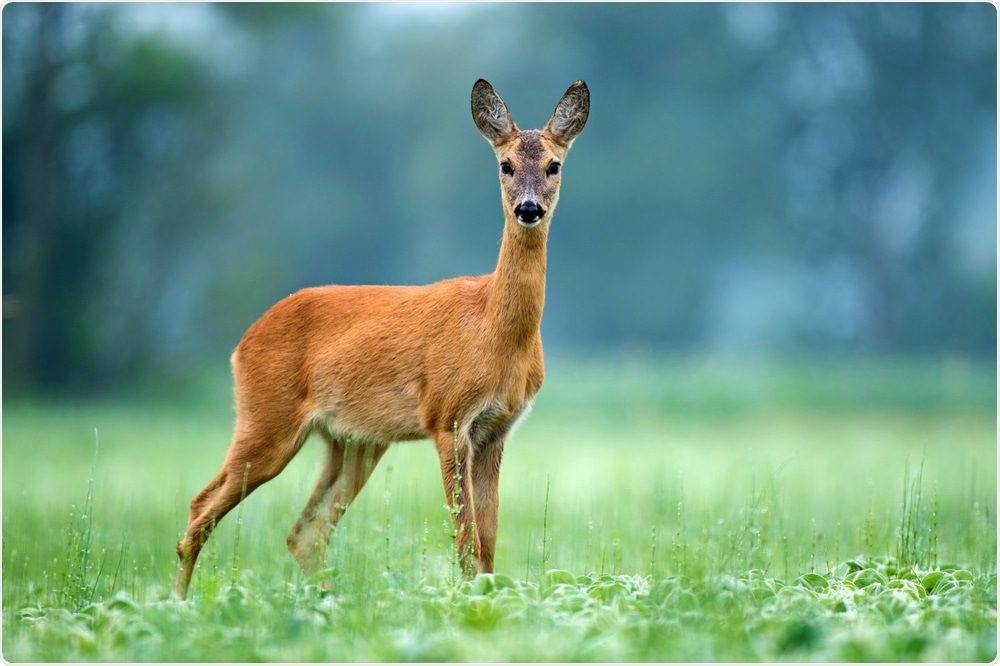The severe acute respiratory syndrome coronavirus 2 (SARS-CoV-2), which is the virus responsible for the coronavirus disease 2019 (COVID-19), is a novel coronavirus in the genus Betacoronavirus that was first identified in Wuhan, China toward the end of 2019. SARS-CoV-2 continues to evolve with growing concern for the emergence of new variants.
Thus far, SARS-CoV-2 transmission in non-human free-living animals has not been documented, even though they could potentially act as reservoirs. A new study published on the bioRxiv* preprint server tests the hypothesis that white-tailed deer (WTD) are susceptible to SARS-CoV-2 infection and determines whether experimentally infected fawns transmit the virus to other captive deer.
 Study: Multiple spillovers and onward transmission of SARS-Cov-2 in free-living and captive White-tailed deer (Odocoileus virginianus). Image Credit: Soru Epotok / Shutterstock.com
Study: Multiple spillovers and onward transmission of SARS-Cov-2 in free-living and captive White-tailed deer (Odocoileus virginianus). Image Credit: Soru Epotok / Shutterstock.com
Background
The widespread transmission of SARS-CoV-2 among humans creates opportunities for spillovers into non-human hosts like dogs, cats, zoo animals, and farmed minks. This issue is of utmost importance, as SARS-CoV-2 infection of an animal could result in it becoming a reservoir.
This could also drive the emergence of new variants with the risk of spillback to humans, such as workers on mink farms. Despite the importance of the topic, widespread SARS-CoV-2 transmission in a free-living animal species has not yet been documented.
A new study
It has recently been reported that 40% of free-living white-tailed deer in the United States have antibodies against SARS-CoV-2, which was the main motivation behind the current study. Additionally, there is not enough evidence of SARS-CoV-2 transmission among experimentally infected deer in controlled environments.
Scientists have wondered if infection and subsequent transmission of SARS-CoV-2 of deer occur in nature. To answer this question, the researchers of the current study have assayed 283 retropharyngeal lymph node (RPLN) samples from free-living and captive deer in Iowa from April 2020 through January 2021. The sampling period closely followed the trajectory of the pandemic in Iowa.
Main findings
In the current study, the scientists discovered that one-third of free-living and captive WTD had SARS-CoV-2 nucleic acid in their RPLN samples. The positivity rate in deer rapidly increased, with 22 of 77 RPLN samples showing SARS-CoV-2 RNA in November 2020.
Additionally, 61 of 75 samples tested positive in December of 2020. At the same time, these SARS-CoV-2 infections were peaking in Iowa. Importantly, the results also suggested that many of the animals had a very high viral load.
The fraction of deer testing positive in free settings was significantly higher than those in captive settings. This may be driven by the fact that the RPLN harvested from free-living deer was four times more than captive deer. More research is needed to assess the true reasons for the observed differences in prevalence between free-living and captive deer.
Next, the scientists sequenced the SARS-CoV-2 genomes present in all positive samples. Pangolin version 3.1.11 was used to identify SARS-CoV-2 lineages. The researchers observed that the genomes represented multiple lineages corresponding to viral genotypes circulating contemporaneously in humans.
It must be noted that the sampling from both humans and deer was not representative; therefore, caution should be exercised while interpreting differences in the apparent prevalence of SARS-CoV-2 lineages between deer and human hosts. The phylogenetic analyses, coupled with the temporal and geographic patterns of clustering of SARS-CoV-2 lineages, provide strong evidence of multiple likely zooanthroponotic spillovers from humans to deer.
Research has shown that experimentally infected deer transmit the virus to other susceptible WTD between 3-5 days post-infection; however, deer-to-deer transmission in free-living WTD has not yet been documented. To this end, the scientists applied a molecular epidemiologic approach to explore the temporal patterns of recovery of SARS-CoV-2 lineages from free-living WTD. The results supported the circulation of specific lineages amongst free-living WTD.
Limitations
The samples selected were not representative spatially, as the RPLN samples came from a single state in the United States and the sampling was non-uniform across counties. Additionally, the results of this study do not speak to the Alpha and Delta variants, as the samples tested were from 2020, much before the dissemination of these highly infectious variants. Testing of more recent samples and robust longitudinal sampling could provide important information on the role of deer as a SARS-CoV-2 reservoir and/or variant generator.
Conclusions
A more proactive and robust “One Health” approach to understanding the ecology and evolution of SARS-CoV-2 is needed. It is of paramount importance to study and understand human-animal molecular and ecological interfaces and their relevance to infection transmission and disease. This knowledge will help us predict the next pandemic and control infectious diseases in the years to come.
*Important notice
bioRxiv publishes preliminary scientific reports that are not peer-reviewed and, therefore, should not be regarded as conclusive, guide clinical practice/health-related behavior, or treated as established information.
- Kuchipudi, V. S., Surendran-Nair, M., Ruden, R. M., et al. (2021) Multiple spillovers and onward transmission of SARS-Cov-2 in free-living and captive White-tailed deer (Odocoileus virginianus). bioRxiv. doi:10.1101/2021.10.31.466677. https://www.biorxiv.org/content/10.1101/2021.10.31.466677v2
Posted in: Medical Science News | Medical Research News | Disease/Infection News
Tags: Antibodies, Coronavirus, Coronavirus Disease COVID-19, Evolution, Infectious Diseases, Lymph Node, Nucleic Acid, Pandemic, Research, Respiratory, RNA, SARS, SARS-CoV-2, Severe Acute Respiratory, Severe Acute Respiratory Syndrome, Syndrome, Virus

Written by
Dr. Priyom Bose
Priyom holds a Ph.D. in Plant Biology and Biotechnology from the University of Madras, India. She is an active researcher and an experienced science writer. Priyom has also co-authored several original research articles that have been published in reputed peer-reviewed journals. She is also an avid reader and an amateur photographer.
Source: Read Full Article
